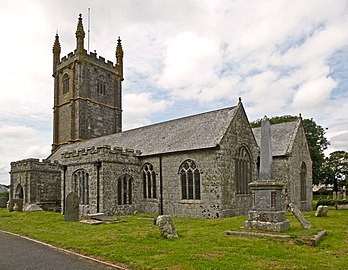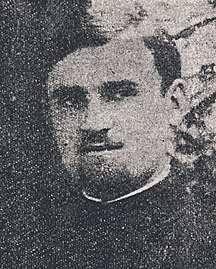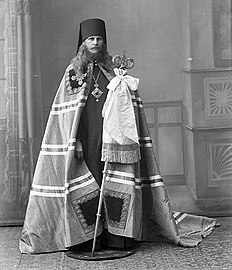June 4 (Eastern Orthodox liturgics)
Appearance

June 3 - Eastern Orthodox Church calendar - June 5
All fixed commemorations below celebrated on June 17 by Orthodox Churches on the Old Calendar.[note 1]
For June 4th, Orthodox Churches on the Old Calendar commemorate the Saints listed on May 22.
Saints
[edit]- Saints Mary and Martha, sisters of Saint Lazarus (1st century)[1][2][3][4][note 2]
- Hieromartyr Astius, Bishop of Dyrrachium in Macedonia (2nd century)[1][5][6][7]
- Saint Titus, Bishop of Byzantium (3rd century)[1][5]
- Holy Martyrs of Niculitsel, Romania (320):[1][5][8][9][note 3]
- Hieromartyr Apotacius and Martyrs Zoticus, Atallus, Camasius, Philip, and 31 others, including:
- Eutychius, Quirinus, Julia, Saturninus, Ninita, Fortunio, Gaddanus, and Amasus, beheaded at Noviodunum (Niculitel), in Scythia Minor.[10]
- Saint Metrophanes of Byzantium, first Archbishop of Constantinople (c. 326)[1][3][11][12][13][note 4]
- Venerable Alonius of Scetis in Egypt (5th century)[1][3][5][15]
- Saint Zosimas of Cilicia, Bishop of Babylon in Egypt (6th century)[1][5][7][16]
- Monk-martyr John, Abbot, of Monagria Monastery, in Cyprus (761)[1][3][5][17][note 5]
- Venerable Sophia of Ainos, Thrace, Mother of Orphans (10th-11th centuries)[1][3][18][19]
Pre-Schism Western saints
[edit]- Saint Clateus, one of the earliest Bishops of Brescia in Italy, martyred under Nero (c. 64)[14][20][21]
- Martyrs Frontasius, Severinus, Severian, and Silanus, of Gaul (1st century)[1][5][7][22]
- Martyr Concordius of Spoleto (c. 175)[1][5][7][23]
- Martyrs Aretius (Arecius, Aregius) and Dacian, in Rome.[14][21][24][note 6]
- Saint Saturnina, a virgin-martyr from Germany murdered near Arras in France.[14][21]
- Saint Quirinus, a martyr in Tivoli near Rome.[14][21]
- Saint Quirinus of Sescia, Bishop of Siscia (Sisak or Seseg), now in Croatia (308)[21][25][note 7][note 8]
- Saint Rutilus and Companions, martyrs at Sabaria (Sabar) in Pannonia, now Hungary.[14][21]
- Saint Optatus, Bishop of Milevum in Numidia (376)[1][5][14][21][note 9][note 10]
- Venerable Nennocha (Ninnoca, Nennoc, Gwengustle), a holy virgin from Britain who followed St Germanus to France, becoming an abbess in Brittany at Ploërmel or Pleumeur-Gautier (c. 467)[21][27][28][note 11][note 12][note 13]
- Venerable Breaca, a disciple of St Brigid who crossed from Ireland to Cornwall (c. 460) with several companions (5th-6th centuries)[21][32][note 14]
- Venerable Petroc (Petrock, Pedrog, Perreux), Abbot, in Cornwall (c. 594)[1][5][21][30][34][35][note 15]
- Saints Croidan, Medan and Degan, three disciples of St Petroc in Cornwall (6th century)[21][36]
- Saint Buriana, born in Ireland, she lived as an anchoress in Cornwall (6th century)[21][note 16]
- Saint Eadfrith of Lindisfarne (Edfrith), Bishop of Lindisfarne in England after St Edbert, he illuminated the Lindisfarne Gospels in honour of St Cuthbert (721)[21][37]
- Saint Alexander, Bishop of Verona in Italy (8th century)[14][21]
- Saint Aldegrin (Adalgrin), a noble who became a monk near Cluny in France (939)[21]
- Saint Elsiar, a monk at Saint-Savin Abbey in Lavedan in France (c. 1050)[21]
Post-Schism Orthodox saints
[edit]- Saint Metrophanes of Radonezh, elder and abbot (14th century)[38][39]
- Venerable Methodius, founder of Peshnosha Monastery, Moscow, disciple of St. Sergius of Radonezh (1392)[1][5][7][40][41][note 17]
- Saint Martirius, archbishop of Novgorod (1199)[42]
- Saints Eleazar and Nazarius, Wonderworkers, of Olonets (15th century)[1][5][43][note 18]
New martyrs and confessors
[edit]- New Hieromartyr Peter Belyaev, Priest (1918)[5][7][44]
- New Hieromartyr Đorđe Bogić, protopresbyter in the Serbian Orthodox Church in Našice, killed by the Ustashas (1941)[7][44][45][46]
- New Hieromartyr Ioannicius (Lipovac), Metropolitan of Montenegro and the Littoral (1945)[1][5][7][47] (see also: June 18 )
Other commemorations
[edit]- Repose of Hieromonk Bartholomew of Neamts and Svir (1864)[1]
- Repose of the righteous sisters Vera (June 4) and Lyubov (June 8), foundresses of the Shamordino Convent (1883)[1]
- Uncovering of the relics (1999) of New Hieromartyr Peter (Zverev), Archbishop of Voronezh and Zadonsk (1929)[7][44][note 19]
Icon gallery
[edit]-
Venerable Nennocha (Nennoc, Ninnoc).
-
Venerable Petroc, Abbot, in Cornwall.
-
Incipit of the Gospel of Matthew from the Lindisfarne Gospels, an illuminated manuscript said to have been created by Eadfrith.
-
New Hieromartyr Ioannicius (Lipovac), Metropolitan of Montenegro and the Littoral.
-
New Hieromartyr Peter (Zverev), Archbishop of Voronezh and Zadonsk.
Notes
[edit]- ^ The notation Old Style or (OS) is sometimes used to indicate a date in the Julian Calendar (which is used by churches on the "Old Calendar").
The notation New Style or (NS), indicates a date in the Revised Julian calendar (which is used by churches on the "New Calendar"). - ^ Name days celebrated today include:
- Martha (Μάρθα).
- ^ Their relics were uncovered in 1971, near the village of Nicolitsel (Niculițel), in the region of Tulcea, Romania.
- ^ "At Constantinople, St. Metrophanes, bishop and renowned confessor."[14]
- ^ According to Saint Nicodemus the Hagiorite, the venerable monk-martyr John was the hegumen of the monastery of Monagria in Cyprus. He was martyred after they tied him in a sack and threw him into the sea.
- ^ Roman martyrs who were buried in the catacombs on the Appian Way.
- ^ Having fled to escape the persecution of Galerius, he was captured and ordered to sacrifice to the gods. He refused, was barbarously beaten and handed over to the governor of Pannonia Prima at Sabaria, now Szombathely, in Hungary. There, on his continued refusal to apostatise, he was drowned in the River Raab.
- ^ "At Sisseck, in Illyria, in the time of the governor Galerius, St. Quirinus, bishop. Prudentius relates that for the faith of Christ he was precipitated into a river, with a milltsone tied to his neck; but as the stone floated on the water, he exhorted for a long time the Christians who were present not to be terrified by his punishment, nor to waver in the faith, and then God heard his prayers to be drowned, that he might attain to the glory of martyrdom."[14]
- ^ Bishop of Milevis in Numidia in North Africa. He opposed Donatism, writing six treatises against them which were praised by his contemporaries.
- ^ "S. Optatus was an African, and was educated as an idolater, but was converted to Christianity, and became bishop of Milevis in Numidia. He is chiefly known by his books against the Donatists, which is a principal source of information concerning these schismatics in the early portion of their history."[26]
- ^ Many miracles are ascribed to her in her legend in the Monastery of the Cross of Quimperle in the Diocese of Quimper in Brittany.[29]
- ^ "ST. NlNNOC was the youngest of the many children of Brecan, Prince of Brecknock, and the sister of many Saints. Her pious parents, though not without reluctance, consented to her choice of a solitary life, which she is supposed to have begun at an early age in Cornwall. Afterwards, however, she removed, with a company of priests and devout persons of both sexes, into Brittany, and settled on the coast in the province of Cornouailles. Ninnoc was well received by the prince of the country, who allowed her to found a monastery, and afterwards made provision for its maintenance. She is said to have lived in this spot during thirty-eight years in all the rigorous practices of the religious life, growing in sanctity and accumulating merits, till she was admitted to joys of the heavenly paradise. The reputation of holiness which she left behind was not confined to Brittany, but spread into other lands; and we find that she is invoked in the ancient English Litanies attributed to the seventh century."[30]
- ^ "[Venerated in Brittany (invoked in a Breton Litany of the 10th cent.). Authority: — The Acts preserved at Quimper, which are, however, fabulous. They were written in the 13th cent, from oral traditions, and are full of anachronisms, and the Bollandists do not publish them in their entirety. As specimens of the anachronisms we may adduce these. S. Columba (d. 597) is said to have baptized S. Nennocha — two hundred years before she was born! Her mother, Moneduc, is said to have been the daughter of Constantine, king of Cornwall and Devon, who died A.D. 576 (see March 11), and he is said to have been descended from Julius Caesar. And S. Germain of Auxerre (d. 448) is made contemporary with S. Turiau, B. of Dol, in the 8th cent., and is sent from Ireland by S. Patrick (d. 465) to Britain. But the Acts, it is very evident, are made out of popular Breton ballads. In one place the writer translates into metre the reply of Moneduc to her daughter.]"[31]
- "The legend of S. Nennocha is pure fable, through which one can scarce discern the outlines of history. According to the legend there was a king in Wales named Breochan, who with his wife Moneduc had fourteen sons, who all deserted him that they might preach the Gospel. Breochan then promised he would yield tithe of all his gold and lands if God would give him another child. In course of time Moneduc brought forth a little girl, who was baptized by the name of Nennocha-Guengustl, and was then given to be fostered by Gurhentil, a kinsman of the king, and his wife Guenargant. At the age fourteen Nenocha returned to her father's house, and was sought in marriage by a prince of Ireland. But S. Germain being then at her father's palace, he persuaded her to embrace the religious life. Breochan sadly gave his consent. Then, the news having spread abroad, a great multitude assembled to accompany S. Nennocha in her renunciation of the world. Among these were four bishops, a crowd of priests and virgins. They all took ship together and sailed to Brittany, and landed at Pullilfyn. The king of the country gave S. Nennocha land at Ploërmel, and there she founded a great monastery where she resided till her death."[31]
- ^ [Anciently venerated on this day in the diocese of Exeter. Authority: — The Ancient Exeter Martyrology of B. Grandison, quoted by Leland.]
- This saint is said, but it is more than questionable, to have been a disciple of S. Patrick. She came to Cornwall from Ireland, and lived a solitary life on the east bank of the river Hayle."[33]
- ^ Born in Wales, he studied in Ireland and settled in Cornwall, where he was very active. He founded a monastery at a place called after him, Petrocstow (Padstow), and another at Bodmin where he reposed.
- ^ St Buryan is named after her.
- ^ See: (in Russian) Мефодий Пешношский. Википе́дия. (Russian Wikipedia).
- ^ They are also commemorated on the Synaxis of the Saints of Novgorod, on the fourth Sunday after Pentecost.
- ^ See: (in Russian) Пётр (Зверев). Википе́дия. (Russian Wikipedia).
References
[edit]- ^ a b c d e f g h i j k l m n o p q r June 4/17. Orthodox Calendar (PRAVOSLAVIE.RU).
- ^ Great Synaxaristes: (in Greek) Οἱ Ἁγίες Μάρθα καὶ Μαρία ἀδελφὲς τοῦ Ἁγίου Λαζάρου. 4 ΙΟΥΝΙΟΥ. ΜΕΓΑΣ ΣΥΝΑΞΑΡΙΣΤΗΣ.
- ^ a b c d e (in Greek) Συναξαριστής. 4 Ιουνίου. ECCLESIA.GR. (H ΕΚΚΛΗΣΙΑ ΤΗΣ ΕΛΛΑΔΟΣ).
- ^ Righteous Martha the sister of Lazarus. OCA - Lives of the Saints.
- ^ a b c d e f g h i j k l m n June 17 / June 4. HOLY TRINITY RUSSIAN ORTHODOX CHURCH (A parish of the Patriarchate of Moscow).
- ^ Hieromartyr Astius the Bishop of Dyrrachium in Macedonia. OCA - Lives of the Saints.
- ^ a b c d e f g h i (in Russian) 4 июня по старому стилю / 17 июня по новому стилю. Русская Православная Церковь - Православный церковный календарь на 2016 год.
- ^ Great Synaxaristes: (in Greek) Οἱ Ἅγιοι Ἀτταλός, Ζωτικός, Κάμασις καὶ Φίλιππος οἱ Μάρτυρες τῆς Ρουμανίας. 4 ΙΟΥΝΙΟΥ. ΜΕΓΑΣ ΣΥΝΑΞΑΡΙΣΤΗΣ.
- ^ Martyrs of Niculitsel. OCA - Lives of the Saints.
- ^ Martyr Eutychius of Niculitsel. OCA - Lives of the Saints.
- ^ Great Synaxaristes: (in Greek) Ὁ Ἅγιος Μητροφάνης Α’ Πατριάρχης Κωνσταντινουπόλεως. 4 ΙΟΥΝΙΟΥ. ΜΕΓΑΣ ΣΥΝΑΞΑΡΙΣΤΗΣ.
- ^ St. Metrophanes the first Patriarch of Constantinople. OCA - Lives of the Saints.
- ^ Rev. Sabine Baring-Gould (M.A.). "S. METROPHANES, B. (A.D. 325.)" In: The Lives of the Saints. Volume the Sixth: June. London: John C. Nimmo, 1897. pp. 33-34.
- ^ a b c d e f g h i The Roman Martyrology. Transl. by the Archbishop of Baltimore. Last Edition, According to the Copy Printed at Rome in 1914. Revised Edition, with the Imprimatur of His Eminence Cardinal Gibbons. Baltimore: John Murphy Company, 1916. pp. 163–164.
- ^ Great Synaxaristes: (in Greek) Ὁ Ὅσιος Ἁλώνιος. 4 ΙΟΥΝΙΟΥ. ΜΕΓΑΣ ΣΥΝΑΞΑΡΙΣΤΗΣ.
- ^ Venerable Father Zosima the Bishop of Babylon. OCA - Lives of the Saints.
- ^ Great Synaxaristes: (in Greek) Ὁ Ἅγιος Ἰωάννης ὁ Ὁσιομάρτυρας. 4 ΙΟΥΝΙΟΥ. ΜΕΓΑΣ ΣΥΝΑΞΑΡΙΣΤΗΣ.
- ^ Great Synaxaristes: (in Greek) Ἡ Ὁσία Σοφία ἐξ Αἴνου. 4 ΙΟΥΝΙΟΥ. ΜΕΓΑΣ ΣΥΝΑΞΑΡΙΣΤΗΣ.
- ^ Venerable Sophia of Ainos. OCA - Lives of the Saints.
- ^ Great Synaxaristes: (in Greek) Ὁ Ἅγιος Κλατέος ὁ Ἱερομάρτυρας Ἐπίσκοπος Βρεσκίας. 4 ΙΟΥΝΙΟΥ. ΜΕΓΑΣ ΣΥΝΑΞΑΡΙΣΤΗΣ.
- ^ a b c d e f g h i j k l m n o p June 4. Latin Saints of the Orthodox Patriarchate of Rome.
- ^ Martyr Frontasius of Gaul. OCA - Lives of the Saints.
- ^ Martyr Concordius of Spoleto. OCA - Lives of the Saints.
- ^ Great Synaxaristes: (in Greek) Οἱ Ἅγιοι Ἀρέτιος καὶ Δακιανὸς οἱ Μάρτυρες. 4 ΙΟΥΝΙΟΥ. ΜΕΓΑΣ ΣΥΝΑΞΑΡΙΣΤΗΣ.
- ^ Rev. Sabine Baring-Gould (M.A.). "S. QUIRINUS, B.M. (A.D. 304.)" In: The Lives of the Saints. Volume the Sixth: June. London: John C. Nimmo, 1897. pp. 30-33.
- ^ Rev. Sabine Baring-Gould (M.A.). "S. OPTATUS, B. C. (ABOUT A.D. 380.)" In: The Lives of the Saints. Volume the Sixth: June. London: John C. Nimmo, 1897. p. 34.
- ^ Very Rev. John O'Hanlon. "Article XIV.—St. Nennoca, or Nennoc, Virgin, of Armorica. [Fifth Century.]" In: Lives of the Irish Saints: With Special Festivals, and the Commemorations of Holy Persons. VOL. VI. Dublin, 1875. pp. 129-135.
- ^ Great Synaxaristes: (in Greek) Ἡ Ὁσία Νιννοκία ἐκ Βρετανίας. 4 ΙΟΥΝΙΟΥ. ΜΕΓΑΣ ΣΥΝΑΞΑΡΙΣΤΗΣ.
- ^ St. Nennoc of the Tribe of St Brychan of Brecknock, Abbess in Brittany (Nenooc, Nennoca, Nennocha, Ninnoc, Ninnocha, Gwengustle). Celtic and Old English Saints. Retrieved: 4 July 2017.
- ^ a b Rev. Richard Stanton. A Menology of England and Wales, or, Brief Memorials of the Ancient British and English Saints Arranged According to the Calendar, Together with the Martyrs of the 16th and 17th Centuries. London: Burns & Oates, 1892. pp. 253–255.
- ^ a b Rev. Sabine Baring-Gould (M.A.). "S. NENNOCHA, V. (8TH CENT.)" In: The Lives of the Saints. Volume the Sixth: June. London: John C. Nimmo, 1897. pp. 36-37.
- ^ Great Synaxaristes: (in Greek) Ἡ Ὁσία Βρεάκη ἐξ Ἰρλανδίας. 4 ΙΟΥΝΙΟΥ. ΜΕΓΑΣ ΣΥΝΑΞΑΡΙΣΤΗΣ.
- ^ Rev. Sabine Baring-Gould (M.A.). "S. BREACHA, V. (5TH OR 6TH CENT.)" In: The Lives of the Saints. Volume the Sixth: June. London: John C. Nimmo, 1897. p. 35.
- ^ Great Synaxaristes: (in Greek) Ὁ Ὅσιος Πετρόκιος ἐξ Οὐαλίας. 4 ΙΟΥΝΙΟΥ. ΜΕΓΑΣ ΣΥΝΑΞΑΡΙΣΤΗΣ.
- ^ Rev. Sabine Baring-Gould (M.A.). "S. PETROCK, AB. (6TH CENT.)" In: The Lives of the Saints. Volume the Sixth: June. London: John C. Nimmo, 1897. p. 35.
- ^ Great Synaxaristes: (in Greek) Οἱ Ὅσιοι Κρουϊδανός, Δαγανὸς καὶ Μεδανὸς ἐξ Ἰρλανδίας. 4 ΙΟΥΝΙΟΥ. ΜΕΓΑΣ ΣΥΝΑΞΑΡΙΣΤΗΣ.
- ^ Great Synaxaristes: (in Greek) Ὁ Ἅγιος Ἔντφριθος ἐξ Ἰρλανδίας. 4 ΙΟΥΝΙΟΥ. ΜΕΓΑΣ ΣΥΝΑΞΑΡΙΣΤΗΣ.
- ^ "Троицкий патерик. Преподобный Митрофан, игумен Радонежский". stsl.ru. Retrieved 2023-07-21.
- ^ "МИТРОФАН РАДОНЕЖСКИЙ - Древо". drevo-info.ru (in Russian). Retrieved 2023-07-21.
- ^ Great Synaxaristes: (in Greek) Ὁ Ὅσιος Μεθόδιος ἐκ Ρωσίας. 4 ΙΟΥΝΙΟΥ. ΜΕΓΑΣ ΣΥΝΑΞΑΡΙΣΤΗΣ.
- ^ Venerable Methodius the Abbot of Peshnosha the Disciple of the Venerable Sergius of Radonezh. OCA - Lives of the Saints.
- ^ "МАРТИРИЙ НОВГОРОДСКИЙ - Древо". drevo-info.ru (in Russian). Retrieved 2023-07-20.
- ^ Great Synaxaristes: (in Greek) Οἱ Ὅσιοι Ἐλεάζαρος, Ναζάριος καὶ Εὐμένιος οἱ Θαυματουργοί. 4 ΙΟΥΝΙΟΥ. ΜΕΓΑΣ ΣΥΝΑΞΑΡΙΣΤΗΣ.
- ^ a b c (in Russian) 17 июня (4 июня). Православная Энциклопедия под редакцией Патриарха Московского и всея Руси Кирилла (электронная версия). (Orthodox Encyclopedia - Pravenc.ru).
- ^ Great Synaxaristes: (in Greek) Ὁ Ἅγιος Γεώργιος ὁ Ἱερομάρτυρας ἐκ Κροατίας. 4 ΙΟΥΝΙΟΥ. ΜΕΓΑΣ ΣΥΝΑΞΑΡΙΣΤΗΣ.
- ^ (in Russian) Священномученик Георгий Богич, пресвитер - 17 июня. Православная энциклопедия «Азбука веры». Retrieved: 1 July 2017.
- ^ (in Russian) ИОАННИКИЙ. Православная Энциклопедия под редакцией Патриарха Московского и всея Руси Кирилла (электронная версия). (Orthodox Encyclopedia - Pravenc.ru).
Sources
[edit]- June 4/17. Orthodox Calendar (PRAVOSLAVIE.RU).
- June 17 / June 4. HOLY TRINITY RUSSIAN ORTHODOX CHURCH (A parish of the Patriarchate of Moscow).
- June 4. OCA - The Lives of the Saints.
- The Autonomous Orthodox Metropolia of Western Europe and the Americas (ROCOR). St. Hilarion Calendar of Saints for the year of our Lord 2004. St. Hilarion Press (Austin, TX). p. 41.
- The Fourth Day of the Month of June. Orthodoxy in China.
- June 4. Latin Saints of the Orthodox Patriarchate of Rome.
- The Roman Martyrology. Transl. by the Archbishop of Baltimore. Last Edition, According to the Copy Printed at Rome in 1914. Revised Edition, with the Imprimatur of His Eminence Cardinal Gibbons. Baltimore: John Murphy Company, 1916. pp. 163–164.
- Rev. Richard Stanton. A Menology of England and Wales, or, Brief Memorials of the Ancient British and English Saints Arranged According to the Calendar, Together with the Martyrs of the 16th and 17th Centuries. London: Burns & Oates, 1892. pp. 253–255.
Greek Sources
- Great Synaxaristes: (in Greek) 4 ΙΟΥΝΙΟΥ. ΜΕΓΑΣ ΣΥΝΑΞΑΡΙΣΤΗΣ.
- (in Greek) Συναξαριστής. 4 Ιουνίου. ECCLESIA.GR. (H ΕΚΚΛΗΣΙΑ ΤΗΣ ΕΛΛΑΔΟΣ).
- (in Greek) 04/06/2017. Ορθόδοξος Συναξαριστής.
Russian Sources
- (in Russian) 17 июня (4 июня). Православная Энциклопедия под редакцией Патриарха Московского и всея Руси Кирилла (электронная версия). (Orthodox Encyclopedia - Pravenc.ru).
- (in Russian) 4 июня по старому стилю / 17 июня по новому стилю. Русская Православная Церковь - Православный церковный календарь на 2016 год.
- (in Russian) 4 июня (ст.ст.) 17 июня 2014 (нов. ст.). Русская Православная Церковь Отдел внешних церковных связей. (DECR).











